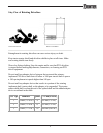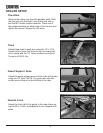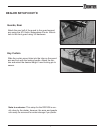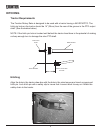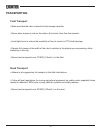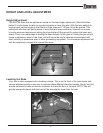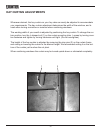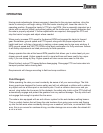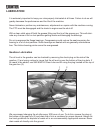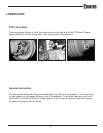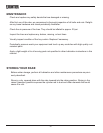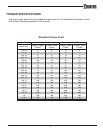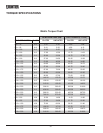
13
OPERATING
Having made adjustments (where necessary) described in the previous sections, drive the
tractor to where you will begin raking. With the tractor standing still, lower the rake to it’s
operating position. Engage the tractor’s PTO at a low RPM, (this is especially important on a
tractor with an electric clutch) and without getting off the tractor seat, visually determine that
the rake is properly adjusted. If further adjustments are required, disengage the PTO and
stop the tractor’s engine and adjust where needed.
When ready, increase PTO speed to the desired RPM and engage the tractor’s forward
gear. Remember, ground speed and PTO speed, along with the proper adjustment for
height and level, will play a large role in making a clean sweep and a nice even windrow. 6
MPH ground speed and 350 PTO RPMs is the ideal combination for uffy windrows. Adhere
to all safety requirements as listed previously for eld operation.
Always operate the rake at the lowest RPM possible that allows you to rake cleanly at your
chosen ground speed. Higher speeds result in more leaf loss and lower quality hay, espe-
cially if you are raking dry hay. Higher speeds will also cause more wear on the rake.
When nished, reduce PTO speed before disengaging. Disengage PTO and raise rake into
transport position before leaving eld.
Requirements will change according to eld and crop conditions.
Field Dangers
While operating the rake you must constantly be aware of all your surroundings. The fold-
down guards are designed for human safety and will not withstand a collision with a station-
ary object such as a fence post or an electric pole. If such a collision does occur and you
cannot stop before the tine arms hit the obstacle, the safety slip clutch on the PTO shaft will
automatically engage and protect the gearbox from any serious damage. The slip clutch will
not engage fast enough to protect the tine arms.
The rake is also equipped with an anti rollover system for the axle tandem walking beams.
This is a safety feature that will keep the axle tandems from going over center and ipping
up into the tine arms when accidently driving over a washout, sink hole, or animal den. How-
ever, this is no excuse for careless driving, as other damage can occur when the wheels hit
a rut or a hole.



